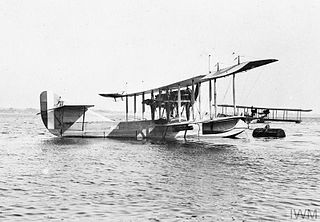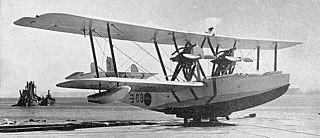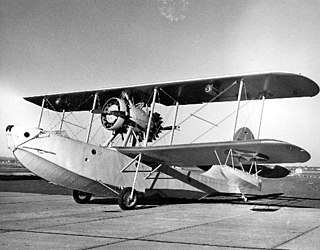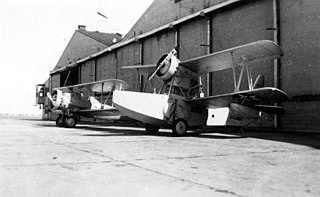
The Martin P5M Marlin, built by the Glenn L. Martin Company of Middle River, Maryland, was a twin piston-engined flying boat that entered service in 1951, and served into the late 1960s with the United States Navy performing naval patrols. It also served with the United States Coast Guard and the French Navy. 285 were produced.

The Martin PBM Mariner was a twin-engine American patrol bomber flying boat of World War II and the early Cold War era. It was designed to complement the Consolidated PBY Catalina and PB2Y Coronado in service. A total of 1,366 PBMs were built, with the first example flying on February 18, 1939, and the type entering service in September 1940, with the last of the type being retired in 1964.

The Curtiss SOC Seagull was an American single-engined scout observation seaplane, designed by Alexander Solla of the Curtiss-Wright Corporation for the United States Navy. The aircraft served on battleships and cruisers in a seaplane configuration, being launched by catapult and recovered from a sea landing. The wings folded back against the fuselage for storage aboard ship. When based ashore or on carriers the single float was replaced by fixed wheeled landing gear.

The Vought FU was a biplane fighter aircraft of the United States Navy in service during the late 1920s.

The twin-engine F5L was one of the Felixstowe F series of flying boats developed by John Cyril Porte at the Seaplane Experimental Station, Felixstowe, England, during the First World War for production in America.

The Felixstowe F.2 was a 1917 British flying boat class designed and developed by Lieutenant Commander John Cyril Porte RN at the naval air station, Felixstowe during the First World War adapting a larger version of his superior Felixstowe F.1 hull design married with the larger Curtiss H-12 flying boat. The Felixstowe hull had superior water contacting attributes and became a key base technology in most seaplane designs thereafter.

The Felixstowe F.5 was a British First World War flying boat designed by Lieutenant Commander John Cyril Porte RN of the Seaplane Experimental Station, Felixstowe.

The Curtiss Model H was a family of classes of early long-range flying boats, the first two of which were developed directly on commission in the United States in response to the £10,000 prize challenge issued in 1913 by the London newspaper, the Daily Mail, for the first non-stop aerial crossing of the Atlantic. As the first aircraft having transatlantic range and cargo-carrying capacity, it became the grandfather development leading to early international commercial air travel, and by extension, to the modern world of commercial aviation. The last widely produced class, the Model H-12, was retrospectively designated Model 6 by Curtiss' company in the 1930s, and various classes have variants with suffixed letters indicating differences.

The Consolidated P2Y was an American flying boat maritime patrol aircraft. The plane was a parasol monoplane with a fabric-covered wing and aluminum hull. The aircraft was also made by Martin as the P3M, due to an open production contract.

The Norman Thompson N.T.4 was a twin-engined British flying boat of the First World War. Although less well known than similar Curtiss and Felixstowe flying boats, 50 were ordered for Britain's Royal Naval Air Service.

The Naval Aircraft Factory PN was a series of open cockpit American flying boats of the 1920s and 1930s. A development of the Felixstowe F5L flying boat of the First World War, variants of the PN were built for the United States Navy by Douglas, Keystone and Martin.

The Curtiss HS was a single-engined patrol flying boat built for the United States Navy during World War I. Large numbers were built from 1917 to 1919, with the type being used to carry out anti-submarine patrols from bases in France from June 1918. It remained in use with the US Navy until 1928, and was also widely used as a civil passenger and utility aircraft.

The Martin T3M was an American torpedo bomber of the 1920s. A single-engined three-seat biplane, it became a standard torpedo bomber of the U.S. Navy, operating from both land bases and from aircraft carriers from 1926 to 1932.

The Fokker T.IV was a Dutch torpedo bomber/maritime reconnaissance floatplane of the 1920s and 1930s. First flying in 1927, it served with the Dutch Naval Aviation Service in the Dutch East Indies until the remaining aircraft were destroyed during the Japanese invasion in 1942.

The Berliner-Joyce OJ was an American biplane observation floatplane developed by the Berliner-Joyce Aircraft for the United States Navy during the early 1930s.

The Hiro H1H was a 1920s Japanese bomber or reconnaissance biplane flying boat developed from the Felixstowe F.5 by the Hiro Naval Arsenal for the Imperial Japanese Navy. The aircraft were built by Hiro, the Yokosuka Naval Arsenal and Aichi.

The Douglas XP3D was a prototype American patrol flying boat of the 1930s. A twin-engined high-winged monoplane, the P3D was produced by the Douglas Aircraft Company to equip the US Navy's Patrol squadrons, but despite meeting the Navy's requirements, the rival Consolidated PBY was preferred owing to a lower price.

The Hiro H2H, or "Navy Type 89 Flying boat", was a Japanese patrol flying boat of the 1930s. Designed and built by the Hiro Naval Arsenal, it was a twin-engined biplane that was operated by the Imperial Japanese Navy.

The Sikorsky XP2S was an American biplane patrol flying boat developed for the United States Navy during the early 1930s.

The Loening XS2L was an American biplane scout amphibian developed by Keystone-Loening, for the United States Navy during the early 1930s.





















